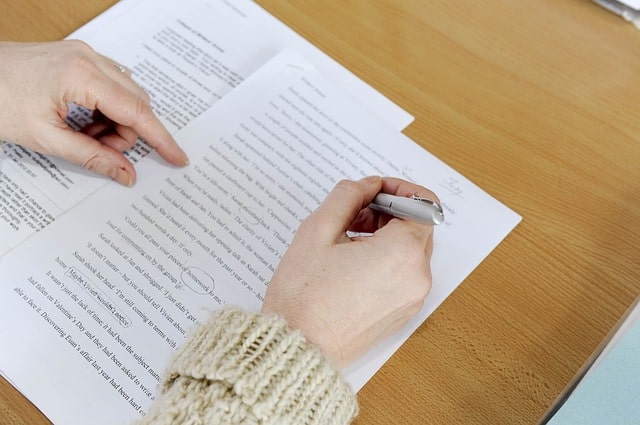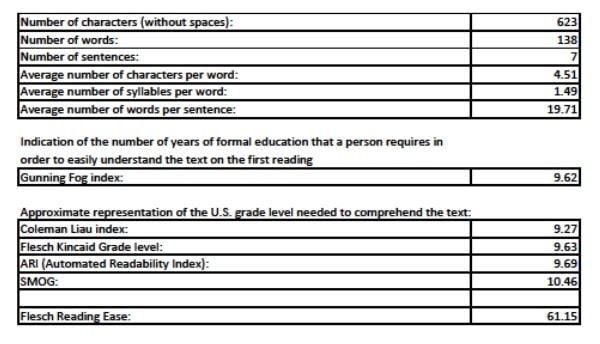11 Common Editing and Typo Mistakes to Watch for in Your Own Book and How to Fix Them
August 15, 2022
Have you ever read a piece of writing, be it a book, article, or even a blog or social media post, that just leaves you shaking your head, wondering what the author was trying to say?
Don’t let this be you or your book!
From fragmented sentences and misspelled words, to lack of punctuation — good ideas getting lost in bad writing is an all-too-common occurrence nowadays.
It’s important to use correct grammar and spelling when writing your book so you can clearly get your message across while making the flow of the writing unobtrusive and easy to understand. Otherwise, you risk losing your reader altogether. And, if you don’t lose the reader, you at least risk them questioning your knowledge and expertise on the topic you’re writing about.
Always proofread your book, or any other piece of writing, with an eye to these 11 common mistakes that detract from your book’s message and potentially diminish your credibility as an author or expert in your field.
Mistake 1: Word Usage
English is actually a pretty tough language! One reason is the number of words that have multiple meanings with different sounds and spellings. It is quite common to get these words mixed up and use the wrong word or spelling in your writing.
For instance, consider:
- “Your” vs. “you’re” — One is possessive, and the other is a contraction of the words “you” and “are.”
- “To” vs. “too” vs. “two” — The first is a preposition while the second can mean “excessive” or “also,” and the last one refers to a number.
- “There” vs. “their” vs. “they’re” — The first is a location, the second is a possessive word, and the last one again is a contraction of the words “they” and “are.”
- “Accept” vs. “Except” — Accept means to consent to accept, agree, or come to believe something is valid. “Except” means to exclude. Examples: She accepted his behavior because she loved him. She would believe what he said except it was common for him to lie.
As you can see by these examples, word usage is very important as it can completely change the meaning of what you’re trying to say. It can confuse your reader or, at the very least, distract them from the flow of your writing.
There are certainly too many words like this to give every example, so when in doubt about the correct word and usage, try these helpful references from Inc., English Oxford Living Dictionaries, or Oxford Royale Academy.
Mistake 2: Punctuation
The use of proper punctuation really can make or break the meaning of what you’re trying to say.
It helps readers know when to pause or stop and when a question is being asked, and keeps sentences from running altogether, which only creates confusion.
A couple of examples that went viral online not long ago shows the perfect reason correct punctuation is so important:

- “Let’s
eat, Grandpa!” vs. “Let’s eat Grandpa!” - “A woman,
without her man, is nothing.” vs. “A woman: without her, man is nothing.”
As you can see, the usage of simple commas completely change the meaning of the sentence!
Here are a few other examples of incorrect and correct punctuation to watch out for:
- “Are you
going to eat that.” vs. “Are you going to eat that?” - “Its fun
to dream about my upcoming vacation.” vs. “It’s fun to dream about my upcoming
vacation.” - “I love
cooking my pets and my family.” vs. “I love cooking, my pets, and my family.” - “My mom
likes cake. My dad likes pie.” vs. “My mom likes cake; my dad likes pie.” While
both technically correct, using a semicolon allows you to take two similar
sentences and make them into one while still keeping the flow.
Mistake 3: Tense Usage
The tense usage refers to past, present, and future in writing as it relates to your verb or action.
- Past tense is, “Sarah ate the apple.”
- Present tense is, “Sarah eats the apple.”
- Future tense is, “Sarah will eat the apple.”
You wouldn’t write, “Peter sat (past tense) at the table. He waits (present tense) for her to show up and join him.” It would be, “Peter sat at the table and waited for her to show up to join him.”
You also wouldn’t write, “Peter sits (present tense) at the table waiting (present tense) for her to show up and join him. But she never arrived (past tense).” You might write instead, “Peter sits at the table waiting for her to show up to join him. But she isn’t arriving.”
When you’re editing your book, look for and highlight any inconsistent tense usage. No matter which tense you choose to use, keep all your verbs constant with that tense.
Mistake 4: Point of View
Point of view includes first person (I, talking about oneself), second person (you, as talking directly to the reader), and third person (he/she/they).
Once you’ve picked the appropriate point of view and written your book, you want to be sure you’ve maintained that point of view throughout the writing.
Look at your pronoun usage and make sure you aren’t combining several points of view together. If you are writing in the third person, you won’t want to slip into the first person or vice versa.
- “I
moved to California when I was 4 years old. He was so young he
didn’t remember much about that move.” - “David
was impressed by the size of the tractor. He had never seen one that big
before. I was truly in awe of it.”
Mistake 5: Passive Voice
Most of us have heard, most likely from our high school English teachers, that we need to “show and not tell” in writing. But what exactly does that mean? What is passive voice writing?
It all comes down to weak vs. strong verbs.
Writing comes alive when you use strong verbs instead of weak or lazy verbs that need an adverb (words ending in “ly”) to help describe it. Also, using few adjectives – if any – and cutting out “to be” forms of verbs will make your writing stronger and more engaging.

Also, try writing your sentence in a different order.
Most passive voice writing is based on the subject of your sentence having something done to it. To turn it into active voice, have your strong verbs coming from your subject instead.
Also, try writing your sentence in a different order. Most passive voice writing is based on the subject of your sentence having something done to it. To turn it into active voice, have your strong verbs coming from your subject instead.
Consider these examples:
- “The treaty is being signed by the two leaders.”
(passive) - “The two leaders are signing the treaty.”
(active) - “The baby was delivered by the inexperienced
doctor.” (passive voice with object, verb, subject sequence - “The inexperienced doctor delivered the baby.”
(active voice with subject, verb, object sequence)
As you read through your book, highlight every adverb and adjective and then go back and replace them using stronger, move active, more compelling verbs. By doing this, you will find it takes care of removing the “to be” verb forms as well.
Mistake 6: Sentence Structure and Length
When editing, review how you structured your sentences. Keep an eye out not only for the correct punctuation but that you have all the correct parts to your sentence (specifically a subject/noun and an action/verb) to make it complete. Certainly, you can use fragmented sentences for emphasis or to make a point, but it needs to be done properly or you’ll just confuse your reader.
You’ll also want to edit your sentences for length and complexity. Make sure you have varied both shorter and longer sentences in your writing to create rhythm. Short of sentences can read choppy and too long of sentences can ramble on, both making it hard for your reader to follow your thought.
While there is no concrete rule to the actual number of words to have in your sentences, the length of them depends a lot on the type and style of your writing. For a more technical style, you’ll find sentences that are more complex and longer than say your online blog post or article. Online writing typically will use shorter sentences and smaller paragraphs. Nonfiction books will be different from those styles as well as from fiction.
In essence, what you’re going for is readability, rhythm, and flow.
Use this free online tool to check your own writing’s readability and get a report like this one:

Mistake 7: Repetition in Sentences and Paragraphs
How many of your sentences start with pronouns?
“He put his arm around her. She shrugged it off, feeling uncomfortable. He looked at her in irritation. She smiled and walked on ahead of him. He walked faster to catch up.”
When you start each sentence with a pronoun, one right after the other, your writing comes across as stilted and dull. And, you want your writing to sparkle!
As you edit your book, look for all your pronouns and see where you can vary your sentence structure to liven up your writing. There are many ways to start a sentence, whether with a pronoun (he/she/it), a proper noun (David/Kathy), or with a dependent clause (With the exception of pizza, Kathy never eats in bed.)
Switching up how you start your sentences will help readers better engage with your writing and make it even more interesting for you.
Mistake 8: Redundancy
While many readers may not catch redundancies in your writing, you can make your book and its message crisper and stronger to your audience by simply removing extra words that are redundant.
What do I mean by redundant? Different than repetition in the previous mistake above, it is the use of excessive words that mean the same thing within your writing.
Look for wording like these examples:
- “Her problem first began when he showed up at her door.” Better to write, “Her problem began when he showed up at her door.”
- “It was the final outcome that caused her to collapse to her knees.” In this sentence, simply write “the outcome.”
- “John asked her if they could collaborate together on the new project.” Collaborating is doing something together, so it would be better to write, “John asked her if they could collaborate on the new project.”
- “The gunman was armed as he entered the bank.” If he was a gunman, then he was armed so there is no need to mention it.
- “The ice was frozen to the middle of the pond.” Ice is always frozen so simply reword the sentence to take out the redundancy. It would be better to say something like, “The ice reached the middle of the pond.”
Certainly, there are many other redundancies that can be and are used that simply bog down otherwise good writing. Highlight these redundancies in your own writing and come back to tighten up your sentences to make them stronger.
Mistake 9: Singular Nouns/Plural Pronouns
Make sure you’re using the correct nouns and pronouns together. If you’re writing about a single subject you want to make sure you use a single pronoun with it.
This common mistake often occurs when a writer is trying to use a pronoun that isn’t gender-specific.
Instead of writing, “The client (singular) may get their (plural) ticket at the front entrance,” write “The client may pick up his or her ticket at the front entrance.” Or, if you’re writing about more than one client, you can word it as, “The clients (plural) may pick up their (plural) tickets at the front entrance.”
While it can be tedious to have to always write “his or her,” without a non-gender-specific pronoun in the English language you can write it as “his or her” for the singular pronoun or work to restructure your sentence so you eliminate the need to use a pronoun altogether, such as, “Clients may pick tickets up at the front entrance.”
Mistake 10: Inconsistencies in Presentation
Inconsistencies in presentation refer to how you refer to a word, phrase, or idea and present it within your book consistently.
As an example, if you are writing a book about Type 1 diabetes, which also could be written as Type 1 Diabetes; Type I Diabetes, Type One Diabetes, or juvenile diabetes), you want to use the same terminology each time you refer to it. If there several ways you can reference the idea or topic, then pick the most commonly used one and present it consistently within your writing.
Mistake 11: Typos
It isn’t unusual to have typos in your manuscript, which is why it is so important to proofread your book several times before completion. Whether your fingers are just on the wrong keys or you type too fast, it’s common to see dropped letters, missing or misplaced apostrophes, and switched letters that your spellchecker or grammar program won’t find on its own. Oftentimes your typo will be a real word that you didn’t even intend to use.
Read through your book at the editing stage to find these mistakes. Look for things like:
- dropped letters such as “an” vs. “and” or “the” vs. “they”
- missing apostrophes such as “its” vs. “it’s”
- incorrect word usage such as “than” vs. “then”
- wrong verb tense such as “choose” vs. “chose”
- incorrect hyphenation such as “happily employed” vs. “happily employed”
Check out Online Writing Jobs for a handy infographic about catching typos.
Wrapping it Up
These 11 common editing and typo mistakes really can make or break your book. It is important to read over your writing with an eye to the rules of good writing and know that correcting these mistakes will make your book’s message clearer, stronger, and more authoritative.
As harsh as it may sound, your readers will judge your writing and you — your creditability and your expertise — based on how you write as much as by what you write. The importance of editing your book to correct such mistakes can’t be stressed enough, especially if you are using your book to grow your brand, build a business, or set yourself up as an expert in your field.
Don’t let sloppy writing, rushed editing, and easy-to-fix typos deflect from your message to your audience. If you’re unsure of how to properly edit your book for these things, hiring a professional editor is a good option to make your book as professional as possible.































